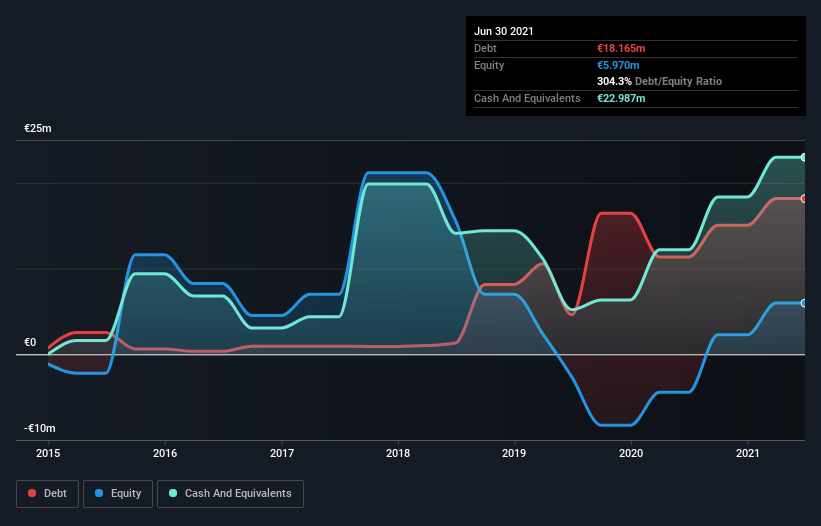Biophytis (EPA:ALBPS) Has Debt But No Earnings; Should You Worry?

Howard Marks put it nicely when he said that, rather than worrying about share price volatility, 'The possibility of permanent loss is the risk I worry about... and every practical investor I know worries about.' So it seems the smart money knows that debt - which is usually involved in bankruptcies - is a very important factor, when you assess how risky a company is. We can see that Biophytis SA (EPA:ALBPS) does use debt in its business. But is this debt a concern to shareholders?
When Is Debt Dangerous?
Generally speaking, debt only becomes a real problem when a company can't easily pay it off, either by raising capital or with its own cash flow. Ultimately, if the company can't fulfill its legal obligations to repay debt, shareholders could walk away with nothing. While that is not too common, we often do see indebted companies permanently diluting shareholders because lenders force them to raise capital at a distressed price. Of course, the upside of debt is that it often represents cheap capital, especially when it replaces dilution in a company with the ability to reinvest at high rates of return. When we examine debt levels, we first consider both cash and debt levels, together.
View our latest analysis for Biophytis
How Much Debt Does Biophytis Carry?
The image below, which you can click on for greater detail, shows that at June 2021 Biophytis had debt of €18.2m, up from €11.4m in one year. However, it does have €23.0m in cash offsetting this, leading to net cash of €4.82m.

How Healthy Is Biophytis' Balance Sheet?
The latest balance sheet data shows that Biophytis had liabilities of €28.4m due within a year, and liabilities of €1.34m falling due after that. Offsetting these obligations, it had cash of €23.0m as well as receivables valued at €6.78m due within 12 months. So its total liabilities are just about perfectly matched by its shorter-term, liquid assets.
Having regard to Biophytis' size, it seems that its liquid assets are well balanced with its total liabilities. So it's very unlikely that the €55.9m company is short on cash, but still worth keeping an eye on the balance sheet. Despite its noteworthy liabilities, Biophytis boasts net cash, so it's fair to say it does not have a heavy debt load! There's no doubt that we learn most about debt from the balance sheet. But ultimately the future profitability of the business will decide if Biophytis can strengthen its balance sheet over time. So if you're focused on the future you can check out this free report showing analyst profit forecasts.
Given its lack of meaningful operating revenue, Biophytis shareholders no doubt hope it can fund itself until it has a profitable product.
So How Risky Is Biophytis?
We have no doubt that loss making companies are, in general, riskier than profitable ones. And we do note that Biophytis had an earnings before interest and tax (EBIT) loss, over the last year. Indeed, in that time it burnt through €24m of cash and made a loss of €25m. Given it only has net cash of €4.82m, the company may need to raise more capital if it doesn't reach break-even soon. Summing up, we're a little skeptical of this one, as it seems fairly risky in the absence of free cashflow. The balance sheet is clearly the area to focus on when you are analysing debt. However, not all investment risk resides within the balance sheet - far from it. For example Biophytis has 6 warning signs (and 2 which are concerning) we think you should know about.
Of course, if you're the type of investor who prefers buying stocks without the burden of debt, then don't hesitate to discover our exclusive list of net cash growth stocks, today.
Valuation is complex, but we're here to simplify it.
Discover if Biophytis might be undervalued or overvalued with our detailed analysis, featuring fair value estimates, potential risks, dividends, insider trades, and its financial condition.
Access Free AnalysisThis article by Simply Wall St is general in nature. We provide commentary based on historical data and analyst forecasts only using an unbiased methodology and our articles are not intended to be financial advice. It does not constitute a recommendation to buy or sell any stock, and does not take account of your objectives, or your financial situation. We aim to bring you long-term focused analysis driven by fundamental data. Note that our analysis may not factor in the latest price-sensitive company announcements or qualitative material. Simply Wall St has no position in any stocks mentioned.
Have feedback on this article? Concerned about the content? Get in touch with us directly. Alternatively, email editorial-team (at) simplywallst.com.
About ENXTPA:ALBPS
Biophytis
A clinical-stage biotechnology company, focuses on the development of therapeutics that slow the degenerative processes and improve functional outcomes for patients suffering from age-related diseases.
Medium-low with weak fundamentals.
Market Insights
Community Narratives



